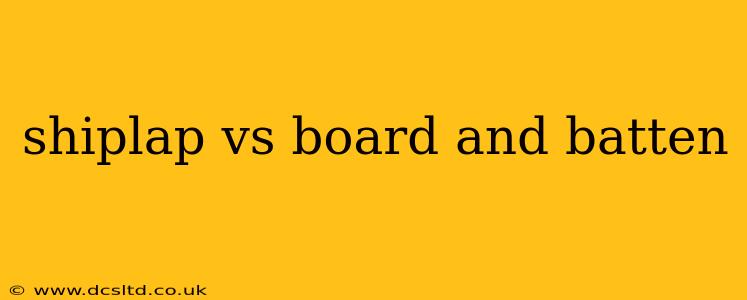Choosing the right siding for your home or renovation project can feel overwhelming. Two popular options frequently top the list: shiplap and board and batten. While both offer rustic charm and visual appeal, they possess distinct characteristics that set them apart. This comprehensive guide will delve into the key differences between shiplap and board and batten, helping you make an informed decision.
What is Shiplap?
Shiplap is characterized by its overlapping horizontal planks. The edges of each plank are beveled, creating a clean, grooved appearance. This overlapping design not only provides a visually appealing aesthetic but also enhances weather resistance and structural integrity. Traditionally used in barns and sheds for its durability, shiplap has become a hugely popular interior and exterior design element, lending a modern farmhouse or coastal vibe to any space.
What is Board and Batten?
Board and batten siding features vertical planks (boards) with narrower strips of wood (battens) covering the seams between them. This creates a more structured, linear look compared to the horizontal flow of shiplap. The battens not only add visual interest but also serve a functional purpose, protecting the joints from the elements. Board and batten exudes a classic, timeless elegance that works well in a variety of architectural styles.
Shiplap vs. Board and Batten: Key Differences
| Feature | Shiplap | Board and Batten |
|---|---|---|
| Orientation | Horizontal | Vertical |
| Appearance | Overlapping planks, clean grooves | Vertical planks with batten covering seams |
| Style | Rustic, modern farmhouse, coastal | Classic, traditional, elegant |
| Installation | Relatively straightforward | Can be more complex due to batten placement |
| Maintenance | Generally low maintenance | Generally low maintenance |
Which is Better for Exterior Use?
Both shiplap and board and batten can be used successfully for exterior applications, but their performance can vary slightly depending on climate and installation. Proper sealing and weatherproofing are crucial for both. However, the vertical orientation of board and batten can sometimes offer a slight advantage in shedding water, particularly in areas with heavy rainfall.
Which is Better for Interior Use?
For interior use, the choice often comes down to personal preference and the desired aesthetic. Shiplap's horizontal lines can make a room feel wider, while board and batten's vertical lines can create a sense of height. Both can add texture and visual interest to a space.
What is the Difference in Cost?
The cost of both shiplap and board and batten can vary significantly depending on the type of wood, quality, and finish. Generally, there's not a massive difference in cost between the two, although intricate designs or premium wood species will naturally increase the price.
How is Shiplap Installed?
Shiplap installation is relatively straightforward. It typically involves nailing or screwing the planks directly onto the wall or substrate, ensuring proper spacing and overlap between each board.
How is Board and Batten Installed?
Board and batten installation requires more precision. The boards are installed first, followed by the battens, which need to be carefully aligned and secured to create a clean, finished look. This may require more skill and time than shiplap installation.
Is Shiplap or Board and Batten More Durable?
Both shiplap and board and batten, when properly installed and maintained, offer excellent durability. The choice of wood species and the quality of the installation will significantly influence the overall lifespan.
By carefully considering the visual appeal, installation complexity, and long-term maintenance, you can choose the perfect siding option to enhance the beauty and functionality of your project. Remember to always consult with a qualified professional for specific guidance on installation and material selection tailored to your needs.
